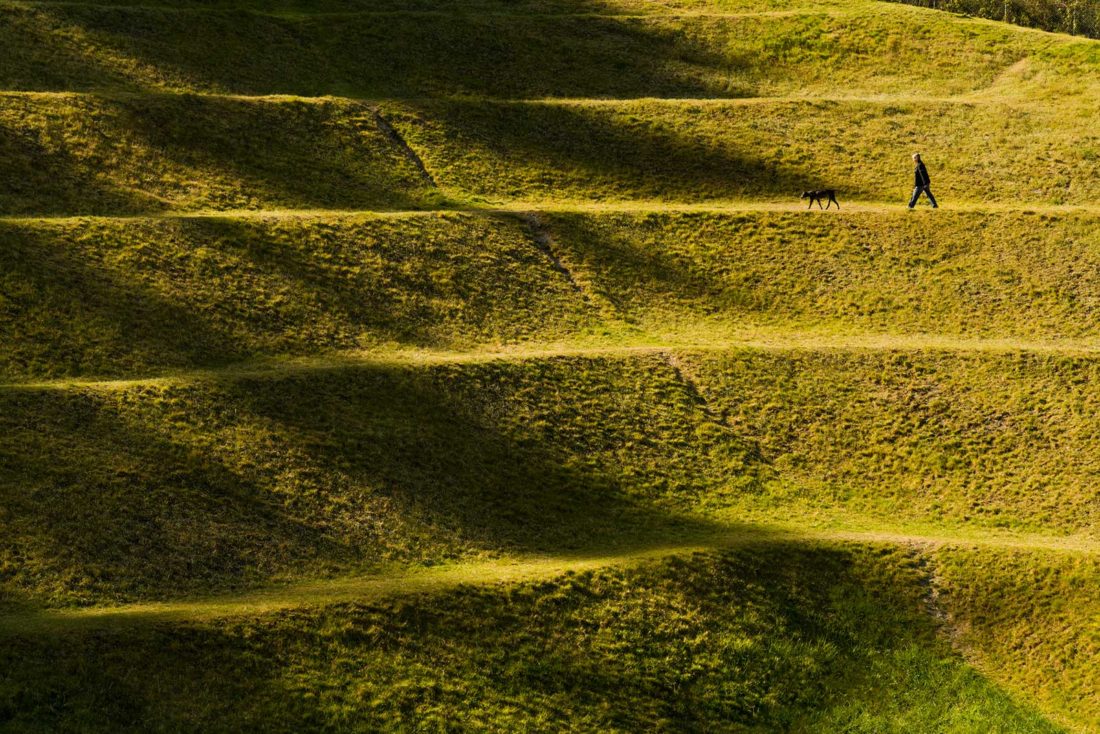Johnson Pit #30
Robert Morris
SeaTac
Rehabilitating a post-industrial gravel pit, this internationally celebrated earthwork provides an enduring community gathering place.

Simplicity of shape does not necessarily equate with simplicity of experience. —Robert MorrisInspired to by early efforts to use art as a means for rehabilitating abused post-industrial sites, 4Culture‚ then known as the King County Arts Commission‚ sponsored an innovative symposium called Earthworks: Land Reclamation as Sculpture in 1979. The event brought together a unique team of government agencies and artists to discuss the potential of earthworks—large-scale sculptures that use the earth itself as their medium—and to create historic public artworks designed to rehabilitate natural areas damaged by industry. Artist Robert Morris received the first demonstration project commission. He removed undergrowth from an abandoned 3.7-acre gravel pit in the Kent Valley, terraced the earth, and planted it with rye grass, in effect returning the land to active use. Decades later, the internationally celebrated destination continues to serve as a community gathering place.
Continue Reading ›
The demonstration site was chosen from among 100 gravel pits overseen by the King County Department of Public Works at the time. The department identified, and ultimately donated, a disused location that was large enough to have a strong visual impact, yet small enough to meet budget limitations, a site that was accessible to the public and offered an appropriate setting for a work of art: Johnson Pit #30, which at the time was mostly reforested with scrub alder, scotch broom, and blackberries. Southeast of the site, agriculture in the valley unfurled toward Mount Rainier. Despite the hillside’s beautiful view, the pit itself had been used as a dumping ground for years.
Morris, already an internationally influential sculptor, painter, performance artist, and writer then based in New York, had experience with land art, including Steam Work for Bellingham on the Western Washington University campus. He also had the potential to challenge people’s ideas about sculpture. His selection marked the first time that the King County Arts Commission had awarded a commission to an artist from outside the region.
After an initial visit to the site in January of 1979, Morris submitted a sculptural design that April, proposing to clear the vegetation and build a hill-form using 16,000 cubic yards of earth carved into descending concentric slopes and terraces in the shape of an amphitheater. A row of black tree stumps, which Morris called a “ghost forest” would remain to signal the site’s history prior to becoming a gravel pit. His artwork was completed in November of the same year and later restored in the 1990s and again in 2018.
Untitled Earthwork (Johnson Pit #30) was listed in the Washington Heritage Register and on the National Register of Historic Places in 2021.
I have employed a method of terracing which has been used in ancient times as well as the present. Such a method has produced sites of such widely varying context and purpose as palaces and strip mines, highway embankments and mountainside cultivation. Persian and Mogul gardens were terraced as were the vast amphitheaters of Muyu-uray in Peru…this is a prototypical act in shaping the earth. —Robert Morris
